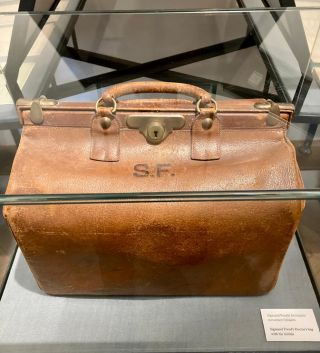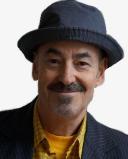Personal Perspectives
On the Freud Trail in Vienna
Revisiting his haunts and related sites.
Updated September 29, 2023 Reviewed by Tyler Woods
Key points
- The father of psychoanalysis did not use the terms Ego, Id and Super Ego.
- There are darker contexts of Freud's favorite coffeehouse and his antiquities-viewing.
- The poisonous anti-semitic mayor of Freud's Vienna gets rejected and righteously defaced.

“It was very interesting, the Freud Museum,” says arch-chronicler of the anxious, Roz Chast. “The large door through which patients entered the consulting room; the small door through which they left. I wondered whether that was the origin of the term ‘shrink’ for a psychiatrist.”
Roz and I and my partner, Anya, are Freud-schmoozing on the worn, velvety couches of the hoary Café Sperl coffeehouse. Roz, whom we know slightly from New York, was in Vienna and visited the museum the day before.
“I also spent time staring at Freud’s travel bag,” she says. “Wondered what he kept in there. Probably a lot of papers and interesting notes. Maybe a schnitzel sandwich. It reminded me of all those old-school businessmen in New York with their briefcases. By the 80s, the briefcases were a lot sleeker... but sometimes you'd see old-guy businessmen toting old-style tan bulky cases and I'd feel a little sad for them.”
I remark how strange that Freud allowed the authoritative English translation of his work by James Strachey to employ the now universal Latin terms, Ego, Id, and Super-Ego. Freud himself never used them. His were vernacular German words: Das Ich (I), Es (It), and Uber-Ich (Over-I).
"I could research this at the museum’s psychoanalytic library. It’s the largest in Europe,” I note. “It’s got 40,000 books.”
Coffeehousing and Dr. Karl Lueger

Freud would take a daily high-speed constitutional along the then-new Ringstrasse, and I intended to replicate his route in one heroic go, but it’s raining nonstop. So, I do things piecemeal. With Anya, I scurry between drops to squeeze past the sodden jam of tourists at Freud’s favorite coffeehouse, the elegant Café Landtmann. Alas, his usual table at the right rear is occupied.
The Landtmann sits on the section of the Ringstrasse called the Universitet Ring, named for the nearby University of Vienna, at whose medical school Freud studied and later taught. From 1934 until 2012, however, the Universitet Ring was called, most shamefully, the Dr. Karl Lueger Ring—named for the brazenly anti-Semitic popular mayor of Vienna in Freud’s time.
Freud, the Jew, famously encountered the arch-antisemite once, appropriately in the netherworld of a Slovenian cave. “Handsome Karl”’s politicking greatly impressed a raving young Viennese resident and future author of Mein Kampf.
A hurrying 10 minutes away, Café Central, which Freud would also frequent, has such a clog of damp tourists we manage only a quick peep under its soaring arches. Here gathered early 20th-century Vienna’s literary lights, such as Arthur Schnitzler and the hyper-eccentric arch-bohemian Peter Altenberg, idolizer of young girls, who hung here so much (when he wasn’t in sanatoriums for his fragile mental health) that his life-size statue still occupies a table. The Central was also favored by exiled revolutionaries like Leon Trotsky—surprisingly a vigorous advocate of psychoanalysis, though he never met Freud.
Antiquities and the Anschluss
Another featured stop on Freud’s Ringstrasse route is the bombastically mammoth Neo-Renaissance pile of the Kunsthistorisches Museum, opened in 1891 about the time Freud moved into Berggasse 19.

Anya and I mount the grandiose staircase to wander the stupendous assemblies of Egyptian and Greek sculptures and objects, great and small, that Freud liked to browse. Then we head for the Breughels and Tintorettos.
The antiquities curator here would advise Freud on his collecting, his additions to his “old and dirty gods," as he called them, for his desk and shelves.
Afterward, I dash right across the Ringstrasse for a drizzly gander at Heldenplatz (Heroes Square), which fronts the looming Hofburg, the imperial place of the Hapsburgs.
From its balcony on March 15, 1938, Karl Lueger’s returning old admirer triumphantly proclaimed the Anschluss, Germany’s annexation of Austria, to a jubilant Viennese crowd. That same day Nazis called at Berggasse 19 and were fobbed off with money.
Sweet Sacher and Its Sacherites
Happily, now, there’s lunch in the plush landmark of the Sacher Hotel, just behind the Vienna Opera. According to psychoanalytic historian Elisabeth Roudinesco, as cited by Nino Shaye Weis, an authority on Vienna and its Jewish food, Freud tended his sweet tooth here with the “original” chocolaty Sachertorte.
We do the same after plates of enormous white spring asparagus. ("I need not interpret asparagus to the initiated.”— Freud).
The young Salvador Dali stayed and "torted" (and perhaps "asparagussed") at the Sacher in 1937 in a futile desperate attempt to meet the great dream interpreter, with whom he was obsessed. (He succeeded in London in 1938).
A couple of decades later, that bitterly hilarious writer and withering excoriator of Vienna and the Austrians, Thomas Bernhard, habituated the Sacher’s café with his “shameless madman” friend, Paul Wittgenstein.

Bernhard scorned psychoanalysis as nonsense (naturally), but he praised Freud as an “extraordinary, magnificent” writer. Freud was a “genuinely great, extraordinary personality…,” he told an interviewer, adding that Freud was “(o)ne of the few great personalities who had a beard and was great despite his beardiness.” (“Do you have something against beards?” asked the bemused interviewer.)
A Rightious Defacing
Our final morning—the rain’s gone since we’re leaving—we’re at Café Prükel with its beloved 1950s design, a seven-minute walk from the golden Johann Strauss monument in Stadtpark. We order the final wursts of our stay.
Then we step out to the small Dr. Karl Lueger Platz adjacent.
In 2013, my previous visit, the grandiose 1926 monument here to that toxic politician had his four-meter-tall statue ennobled and spotless atop a vaunting, elaborate pedestal. But in recent years the local government decided to make the monument instead a living record of public revulsion at the antisemite and his poison.
Lueger’s statue and pedestal are now defaced with graffiti: slimed, smeared, and splashed with paint. And left so.
The city of which he was mayor, the city that would force Freud into exile, consigns Lueger to his unclean shameful fate.
Read my update on Freud’s Museum here.




